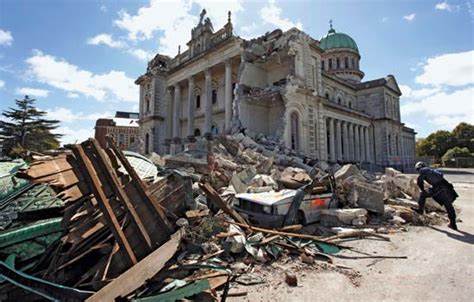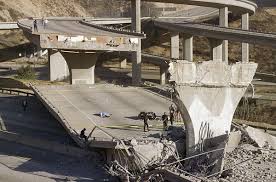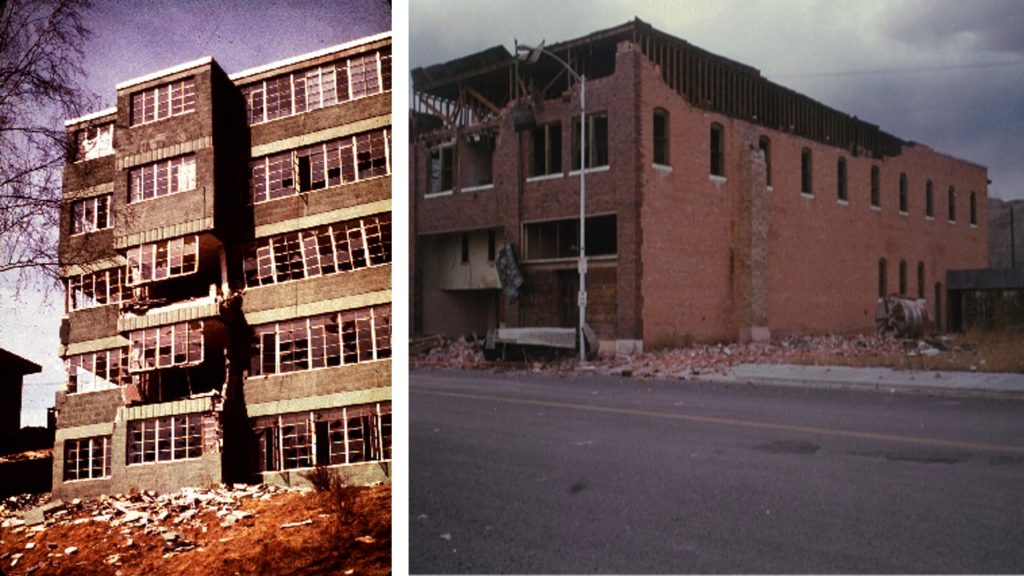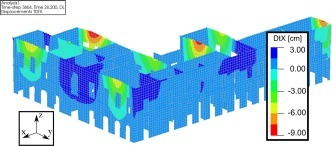Seismic Resilience of Masonry
Words: Richard Rydel
Words and Photos: Richard Rydel, P.E., LEED AP BD+C, Executive Director of the Masonry Institute of America in Torrance, CA
According to recent global data, roughly 62,000 people die every year due to natural disasters. About half of that number is attributed to geophysical events, mostly earthquakes and tsunamis. In addition, there is a global economic loss well above hundreds of billion US dollars per year. Earthquakes are the most destructive natural phenomena that influence our built environment. Significant damage to the building can occur after just seconds of shaking. It is impossible to prevent earthquakes, but what we can do is mitigate their consequences. In the case of most building materials, including masonry, the best way to limit negative effects of earthquakes on masonry structures is to improve their seismic resilience. The seismic resilience of masonry buildings is the capacity of the structure to resist and maintain a certain level of functionality after the seismic event. The best way to achieve this is to implement modern seismic codes in the design and construction, which is associated with the review of the design and quality control of construction.
A general definition of the word ‘resilience’ is the ability to recover quickly from difficulties.
In the context of seismic events, resilience is the capacity to prevent, prepare for, respond to, and recover from the impacts of the earthquakes. The key component of seismic resilience, by far, is prevention.
The moment the earthquake hits, there is a sudden drop in the quality of the infrastructure. If the structures are seismically resistant, the drop is small and recovery is quick. If the structures are not resistant, the drop is large, and the recovery is very long.
 Post-earthquake damage in Haiti, 2012.
Post-earthquake damage in Haiti, 2012.
One of the most extreme examples of the difference in building seismic resilience are the 2010 Haiti and the 2010 New Zealand earthquakes. The magnitude of the Haiti earthquake was 7.0 (Mercalli intensity scale), and it was actually lower than the 7.1 recorded in New Zealand.
However, the consequences were drastically different as there were about 160,000 fatalities, 300,000 wounded and about 75% of Haiti’s GDP lost. This was the most catastrophic earthquake any county has experienced in terms of the number of fatalities relative to its population.
In the case of New Zealand earthquakes, including many strong aftershocks (main one occurred in 2011 in Christchurch with a moment magnitude of 6.3), the total fatalities were less than 200 people. The economic impact was significant but much less than Haiti’s in terms of the GDP.
 Catholic cathedral damaged during 2011 Christchurch, New Zealand earthquake.
Catholic cathedral damaged during 2011 Christchurch, New Zealand earthquake.The most significant reasons for the overwhelmingly worse outcome in the case of the Haiti catastrophe were inadequate construction practices due to poverty, lack of professionals in the construction industry, and no developed and seismically focused building code.
It is important to remember that in the United States and other developed countries around the world, the latest seismic code’s main purpose is to safeguard the public health, safety and welfare of the public and to limit the seismic risk.
When it comes to the seismic resilience, the code can only limit the building’s damage due to earthquakes but not prevent it. The reasons for that are economical, as it is theoretically possible to make a structure fully seismically resistant, but it would be extremely expensive.
In the US, seismic code does not protect against all earthquakes, but for the ones experiencing the ground motion with a 2% in 50 years probability of exceedance which is equivalent to a return period of 2500 years.
Large areas of the United States are prone to earthquakes, and many buildings are of masonry construction. Many of the existing masonry structures, especially the ones built before the 20th century, were constructed based on old regulatory codes that did not take seismic loads into consideration.
 Highway collapse during the 1994 Northridge, California earthquake.
Highway collapse during the 1994 Northridge, California earthquake.A building code requirement that structures be designed to withstand horizontal forces originated in Santa Barbara, California in the mid-1920s. The first edition of Uniform Building Code (UBC) was published in 1928 and included an appendix with non-mandatory matter recommending a minimum lateral design force. After the 1933 Long Beach earthquake, the city of Los Angeles adopted the first earthquake provisions that were mandatory. A devastating M6.6 Sylmar-San Fernando earthquake in 1971 had a major impact on the 1985 UBC seismic code provisions. After the 1994 Northridge earthquake, major changes were implemented in the 2000 International Building Code (IBC) cycle. New “near-fault” seismic design categories were developed where seismic forces on irregular structures were as much as double the required forces in 1994 UBC.
Unreinforced Masonry Buildings (URM) are generally brick buildings constructed prior to 1933, predating modern seismic resistant design and without retrofit show little seismic resilience. They perform poorly in earthquakes as the brick walls (not strengthened with steel reinforcement) disconnect from the building and fall outward, creating hazards for people and sometimes causing the building to collapse. URM Failures have been responsible for deaths in California earthquakes since 1868 and as recently as Loma Prieta in 1989 and San Simeon in 2003. It is worth mentioning that there were no fatalities due to masonry in the 1994 Northridge Earthquake, even though it was the most destructive when compared to Loma Prieta and San Simeon.
The state of California is considered to have the highest seismic activity in the United States, and there are mandatory seismic ordinances that apply to structure types such as unreinforced masonry (URM) buildings. The California URM Law was passed in 1986 and required local governments in high seismic zones to develop an inventory for URM buildings and establish a loss-reduction program. For a handful of California cities, ordinances requiring seismic retrofit were passed—but in most cities, the local ordinances only required that owners identify buildings as being vulnerable. Typically, mandatory compliance dates for URM buildings in California covered by this older generation of seismic ordinances have passed, meaning that most of the buildings in California covered by these older ordinances should be in compliance, and their improved seismic resiliency shall at least allow people to be able to evacuate during the seismic event.
It is important to note that California is not exclusive to devastating earthquakes in the United States. In fact, the largest seismic event ever recorded in the US (and second worldwide) in terms of magnitude occurred on March 27, 1964, in southern Alaska (The Great Alaska Earthquake) with the magnitude of M9.2. In addition to the earthquake, the event triggered a major tsunami that caused casualties and damage from the Kodiak Islands to northern California. Another example is the New Madrid, Missouri earthquake that occurred between December 1811 and February 1812 (including aftershocks) and had magnitudes of up to M7.7. On October 28, 1983, in Borah Peak, central Idaho, an earthquake with M7.3 occurred.
 (Left) Five-story Hillside apartment building with unreinforced masonry walls with steel posts and lintels in Anchorage, Alaska after the March 28, 1964 earthquake.
(Left) Five-story Hillside apartment building with unreinforced masonry walls with steel posts and lintels in Anchorage, Alaska after the March 28, 1964 earthquake.
(Right) Damaged brick building in 1983 Borah Peak, Idaho earthquake.
Reinforced masonry structures’ seismic resilience is overwhelmingly better when compared to unreinforced masonry. The addition of steel rebar makes it possible for the wall to have high tension resistance in addition to inherently substantial compression capacity of masonry. In addition, the ductility of steel reinforcement is one of the main qualities of reinforced masonry that improves its seismic resilience.
There are many examples of reinforced masonry shear walls performing well during seismic events. Most public service facilities, such as police and fire stations, hospitals and commercial construction buildings, had very little wall failure rate in the 1994 Northridge earthquake. The high seismic resiliency of these structures can be attributed mainly to good design review and construction quality control of these buildings.
How can we improve seismic resilience of masonry structures?
One of the best ways would be to improve the ductility of masonry reinforcing shear walls.
There have been several investigative studies done on the seismic performance of reinforced masonry shear wall systems and their dynamic response to earthquakes. The performance-based seismic design of reinforced masonry shear walls correlates the damage state to a specific functionality level and losses of the whole system when the structures experience seismic events.
FEMA P-695 presents the results of masonry structures pushover analysis and incremental dynamic analysis that were used to evaluate system overstrength, ductility, and the collapse capacity of reinforced masonry shear wall archetype. Using pushover analysis, it was observed that walls subjected to higher axial loads were less ductile, and low-rise walls were less ductile than high-rise walls. Also, partially grouted walls were observed to be less ductile, as expected. Therefore, partial grouting should be avoided in order to improve the seismic resiliency of masonry walls.
 Multi-directional Pushover analysis of masonry building.
Multi-directional Pushover analysis of masonry building.Another study was done to compare the performance of flanged walls and end-confined reinforced masonry walls to typical (rectangular) walls. High levels of ductility with small strength degradation were observed for the flanged and end-confined walls compared to the rectangular ones. The use of end-confined boundary elements contributed to the significant savings in the amount of longitudinal reinforcement used in masonry shear walls.
The study strongly recommends using end-confined or flanged masonry walls in future designs of reinforced concrete shear walls.
In summary, looking at the earthquake-induced masonry building damage data all over the world, we can see that there is a strong correlation between the extent of damage to reinforced masonry structures and the date the building was constructed. The damage decreases with the increasing year of construction. This leads to an apparent conclusion that the development of modern seismic codes contributes significantly to the increase in masonry buildings’ seismic resilience. The ability to analyze non-linear behavior of reinforced masonry buildings and draw practical conclusions from it is a great tool that will help the whole masonry industry build more resilient structures in the future. Many times mason contractors in the field feel like the amount of steel is way too excessive, and the construction would be so much easier for everybody if we could just get rid of most of that steel which is associated with difficult installation and grouting of the masonry cells. I hope the information above will shed a new perspective on this issue, as from the seismic resilience standpoint, reinforcing steel and its confinement have been the main contributors in saving people’s lives in the event of an earthquake.
About the Author
Richard Rydel, P.E., LEED AP BD+C, is an Executive Director of the Masonry Institute of America in Torrance, CA. Prior to joining the MIA, he has practiced structural engineering for over twenty years. He graduated from Montana State University in Bozeman, MT in 2000. He worked with several structural engineering consultants: Monroe & Newell Engineers in Denver, CO, Jordan Engineering in Phoenix, AZ, Thornton Tomasetti in Oakland, CA and Gouvis Engineering in Irvine, CA. His expertise includes structural design of schools, hospitals, multi-use/residential buildings, existing building rehabilitation, analysis and repair of existing structures, as well as seismic evaluation and upgrade of existing masonry structures. He is an active member of SEAOSC (Structural Engineering Association of Southern California), the American Society of Civil Engineers, the International Code Council, the American Concrete Institute and The Masonry Society.